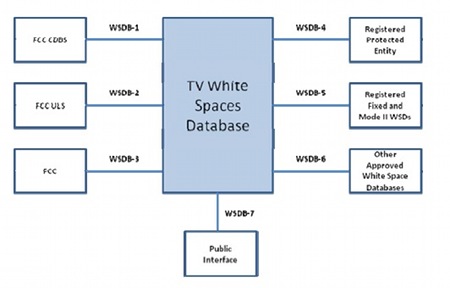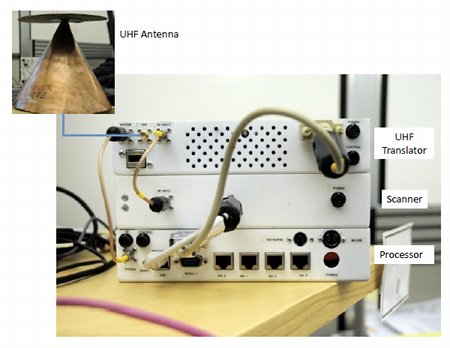Google asks to administer white space networks
Jan 6, 2010 — by LinuxDevices Staff — from the LinuxDevices Archive — viewsGoogle asked the Federal Communications Commission to let it help administer “white space” networking, tapping into unused TV spectrum to deliver broadband services. Yesterday, Google proposed that it be allowed to create a geolocation database that will protect licensed TV and wireless microphone signals from harmful interference, says the company.
White space networking — which has also been called WhiteFi — will rely on radio spectrum that was previously reserved for TV stations. According to Microsoft researchers, who presented a paper on the technology last August at the ACM SIGCOMM in Barcelona, available UHF spectrum includes, but is not limited to, channel 21 (512MHz) to 51 (698MHz), with the exception of channel 37.
At the end of 2008, the FCC issued a ruling permitting the use of unlicensed devices in these "white spaces." The catch is, any new users are not allowed to interfere with any licensed incumbents, which include not only TV stations but also wireless microphones.
Last November, therefore, the FCC approved the concept of databases that would identify incumbent users, including full- and low-power stations, that are entitled to interference protection. The databases, which will be privately owned and operated services, will tell white space devices which TV channels are vacant and may be used at their location.
According to a new eWEEK story by Roy Mark, Google — a key advocate of white space networking — previously said it wasn't interested in being a database administrator. However, Mark adds, the company has now reversed course, asking to create what it describes as a "publicly accessible and searchable" database.
In a Jan. 4 blog posting, Richard Whitt, Google's Washington telecom and media counsel, writes, "We continue to be big believers in the potential for this spectrum to revolutionize wireless broadband, and we think it's important for us to step forward and offer our assistance to make that vision a reality. Since launching the White Spaces Database Group [link] last February, we've been working with other stakeholders to exchange ideas and perspectives on how to best operate a working database, and we believe we're in a strong position to build and successfully manage one."
Google says in its proposal to the FCC that if other database administrators are also selected, it "will cooperate … to develop a process for databases to provide to one another, on a daily basis, information about registered cable TV headends, TV translator station receive sites, operating sites of wireless microphones and other low power auxiliary stations, and fixed white space devices."

Google's proposed white space database architecture
Source: Google
According to Google, data would be traded with other administrators using a standardized interface, designated as WSDB-6 in the figure above. The company's proposal adds, "All database operators should have a functioning synchronization interface, with reasonable published application programming interface (API) specifications, prior to accepting any … registrations and beginning operations. The Commission should reserve the right to audit each database provider to determine that it is providing minimum synchronizing functionality, but should not require that a particular interface be approved or agreed upon with other providers."
Google's proposal says any member of the public should be allowed to search the database's non-confidential information. The company states, "making the database generally accessible to the public will help ensure continued innovation in unlicensed spectrum. Any individual or entity would be able to access and review the data. The public interface would not impact the registration and query functions of the Database, but rather would complement [its] open and transparent nature."
As Mark's eWEEK story points out, the FCC white spaces decision came after a six-year proceeding at the agency that pitted broadcasters and a wide array of entertainment interests against such powerhouse technology firms as Google, Microsoft, Intel, Motorola and Intel. Both Microsoft's Bill Gates and Google's Larry Page are said to have personally lobbied the FCC in favor of the use of white spaces.
SIFTing signals to avoid interference
While the establishment of databases listing incumbent services is a step forward, it remains unclear how well these will deal with the problem of wireless microphones, which potentially operate in the same spectrum as white space networks and may be switched on and off at any time.
In an August 2009 paper, the team of Microsoft researchers (along with two colleagues from Harvard) wrote, "Our experiments show that even a single packet transmission causes audible interference during wireless microphone transmissions." They added that for wireless networking equipment to share UHF spectrum, "both the AP [access point] and its clients must disconnect and then rapidly reconnect using a different available channel."
The paper proposed a solution in the form of a technique called SIFT (Signal Interpretation before Fourier Transform), which would analyze incoming signals to detect transmissions over different channel widths, without having to change the actual channel width of a wireless receiver. As a result, clients could discover when APs have moved to a different operating frequency, the researchers claimed.

Microsoft's KNOWS prototype
(Click to enlarge)
According to one of the researchers, Ranveer Chandra, Microsoft received an experimental license from the FCC allowing it to build a prototype, "campus wide" WhiteFi system on the company's Redmond campus. According to the paper, the team built a hardware device (above) nicknamed KNOWS, which includes a PC, a scanner, a standard WiFi card, and a UHF translator that converts incoming and outgoing 2.4GHz signals to the 512 to 698MHz band.
It's said the scanner samples the UHF spectrum to detect the presence of TV broadcasts and wireless microphone signals. Meanwhile, the SIFT technique is capable of detecting data transmissions, even when they are intermittent and received over multiple channel widths. Finally, WhiteFi provides a "chirping" protocol that lets clients signal when they are disconnected due to a channel conflict, without interfering with a wireless microphone or other primary user.
Availability
Richard Whitt's blog posting, along with Google's full white spaces database proposal to the FCC, may be found on the company's website, here.
The eWEEK story by Roy Mark may be found here.
This article was originally published on LinuxDevices.com and has been donated to the open source community by QuinStreet Inc. Please visit LinuxToday.com for up-to-date news and articles about Linux and open source.